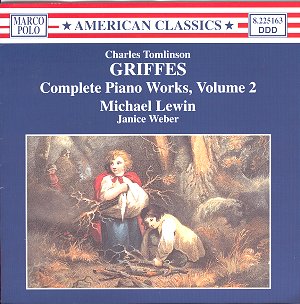Charles Tomlinson GRIFFES (1884 - 1920)
COMPLETE PIANO MUSIC VOLUME 2
The Pleasure Dome of Kubla-Khan (1915)
Three Preludes (1919)
Piece in E major (1916)
Dance in A minor (1916)
Three Fantasy Pieces (1912-15): Barcarolle - Notturno - Scherzo
Piece in D minor (1915)
Piece in B flat major (c.1915)
Humperdinck's Hansel & Gretel Overture transcribed for two pianos
(1910 or before)*
Symphonische Fantasie for two pianos (1910 or before)*
 Michael Lewin (* with Janice
Weber)
Michael Lewin (* with Janice
Weber)
Recorded at the Living Arts Centre, Mississauga, Ontario, Canada, 24-25 July
1999
 MARCO POLO 8.225163
[62:22]
MARCO POLO 8.225163
[62:22]
Crotchet
AmazonUK
AmazonUS

Charles Tomlinson Griffes is one of the tantalising might-have-been figures
dotting the musical landscape. What he might have achieved had he not succumbed
to illness as a result of overwork at the early age of 35 we will never know.
But in his short composing life he had begun as a practitioner of orthodox
romantic music (he was a pupil of Engelbert Humperdinck), then moved to
impressionism, and, in his last years, began to toy with atonality and free
form.
All three phases of his stylistic evolution are covered by this disc. The
pieces for piano duo are the earliest. The Humperdinck transcription is
brilliantly done (it is said to have won the master's approval), catching
the orchestral colours of the original to a remarkable degree. The Symphonische
Fantasie is a transcription of Griffes' own orchestral original (it would
have been interesting if the disc had included the work in that form, as
indeed is the case with his later and best-known piece The Pleasure Dome
of Kubla-Khan which is also a piano transcription of an original orchestral
work). It is a big essay in unashamed late romanticism. The Three Preludes
of 1919 were his last compositions for piano and remain unpublished. Sparse
in texture and enigmatic in mood 'none of them contains any tempo indications,
dynamics, pedal markings or key signature'; the third is notable for one
of the experimental scales which he had already begun to explore in his Piano
Sonata (1918). The remaining pieces are mostly concise miniatures and hover
between romantic and impressionist idioms (Debussy's language and Scriabin's
pianism are notable influences). Larger in scale are the Three Fantasy Pieces,
all displaying a vivid mastery of piano-writing and a creative mind of
distinction.
Performance and recording standards are of the highest. Griffes is a little-known
composer who, unlike some others in the massive Marco Polo and Naxos surveys
of American music, certainly merits a revival.
Adrian Smith
See review of Volume 1 [RB]

